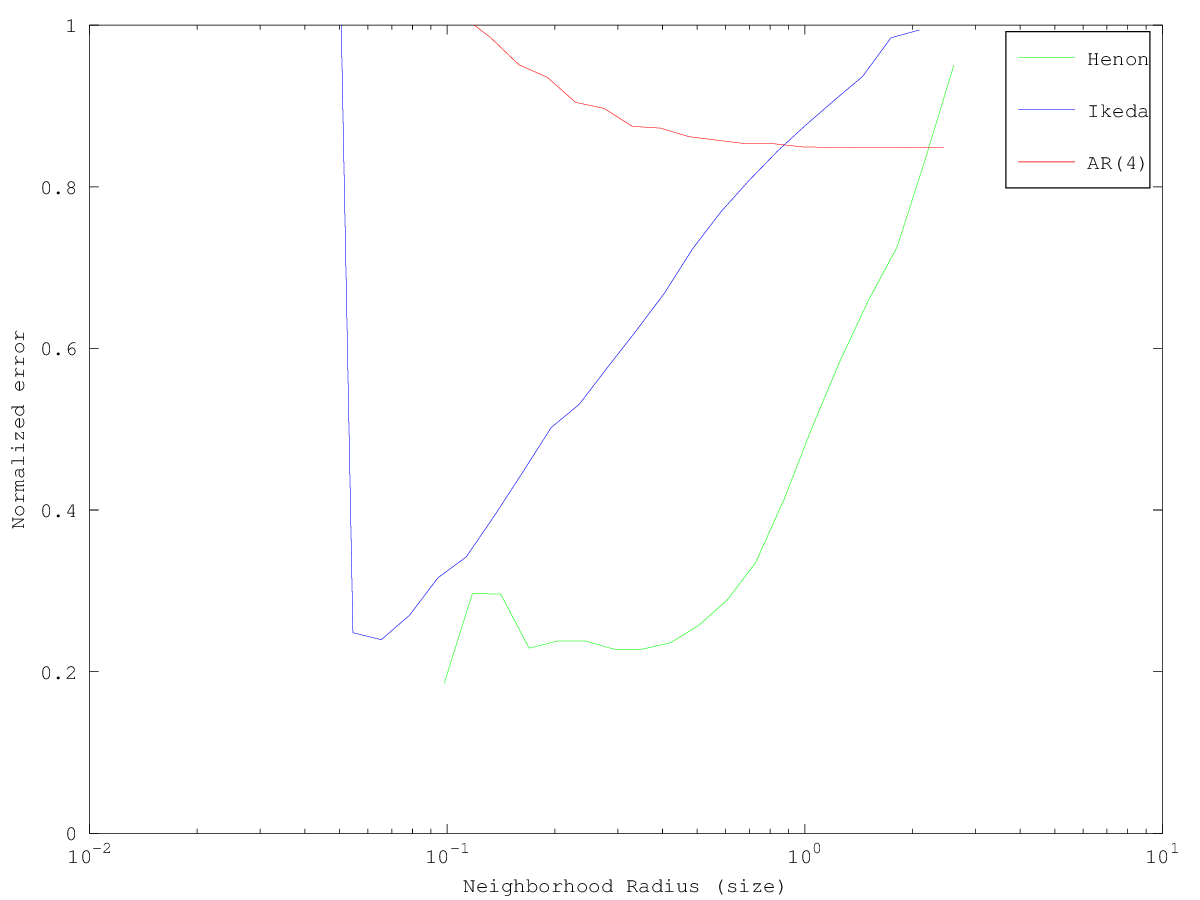- Function File:
output =lzo_gm(S)¶ - Function File:
output =lzo_gm(S, paramName, paramValue, …)¶ -
This program makes a local linear ansatz and estimates the one step prediction error of the model. The difference to lfo-test is that it does it as a function of the neighborhood size. The name "lzo_ar" means ’local first order -> AR-model’.
Input
- S
This function always assumes that each time series is along the longer dimension of matrix S. It also assumes that every dimension (counting along the shorter dimension) of S is considered a component of the time series.
Parameters
- m
The embedding dimension used. It is synonymous to the second part of flag ’-m’ from TISEAN. The first part of the TISEAN flag is omitted as all of the available components of S are analyzed [default = 1].
- d
Delay used for the embedding [default = 1].
- i
For how many points should the error be calculated [default = length (S)].
- rlow
The neighborhood size to start with [default = 1e-3].
- rhigh
The neighborhood size to end with [default = 1].
- f
Factor to increase neighborhood size if not enough neighbors were found [default = 1.2].
- s
Steps to be forecast
x(n+s) = f(x(n))[default = 1].- c
Width of causality window [default = value of parameter s]
Output
The output is alligned with the input. If the components of the input(S) were column vectors then the number of columns of the output is 4 + number of components of S. In this case the output will have the following values in each row:
- Neighborhood size (units of data)
- Relative forecast error ((forecast error)/(variance of data))
- Relative forecast error for the individual components of the input, this will take as many columns as the input has
- Fraction of points for which neighbors were found for this neighborhood size
- Average number of neighbors found per point
See also: demo lfo_ar, lfo_test, lfo_run.
Algorithms
The algorithms for this functions have been taken from the TISEAN package.
Demonstration 1
The following code
verbose = yes_or_no ("Would you like this to be run verbose? (it may take\
a while to complete)\n");
ar4 = arma_rnd([0.3,0.3,-0.3,0.3],[],0.1,1000,100);
if (verbose)
res_hen = lfo_ar (henon(5000)(:,1),'m',4,'d',6,'verbose');
res_ikeda = lfo_ar (ikeda(5000)(:,1), 'm',4, 'd', 3, 'verbose');
res_ar = lfo_ar(ar4,'m',4,'d',1,'verbose');
else
res_hen = lfo_ar (henon(5000)(:,1),'m',4,'d',6);
res_ikeda = lfo_ar (ikeda(5000)(:,1), 'm',4, 'd', 3);
res_ar = lfo_ar(ar4,'m',3,'d',1);
endif
semilogx (res_hen(:,1), res_hen(:,2),'-g',...
res_ikeda(:,1), res_ikeda(:,2),'-b',...
res_ar(:,1), res_ar(:,2),'-r')
ylim([0 1]);
legend ('Henon', 'Ikeda','AR(4)')
xlabel ("Neighborhood Radius (size)")
ylabel ("Normalized error")
Produces the following figure
| Figure 1 |
|---|
 |
Package: tisean